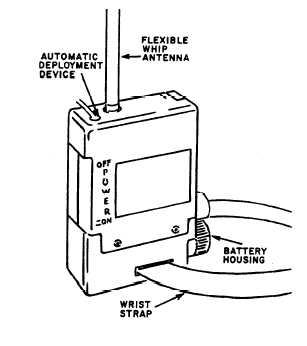is available. One can of water supports a survivor
for about 1 day.
A can of drinking water contains 10 ounces
of pure drinking water and maybe carried in this
ready-to-use state.
The canned drinking water should be inspected
upon issue and every 90 days thereafter, or at
intervals to coincide with the inspection schedule
of the kit or assembly in which the can is stored.
Inspection will consist of the slap test and the shelf
life and service life check.
The slap test consists of slapping the can of
water against the palm of your hand and listening
for a sharp metallic click. This noise is caused by
the absence of air to cushion the impact of the
water against the can. If this distinct noise is not
heard, then air has leaked into the can and it
should be replaced.
The shelf life and the service life of canned
water are both indefinite as long as the cans pass
the slap test and there are no signs of exterior
deterioration.
239.437
Figure 5-7.—AN/PRC-63 radio set.
SURVIVAL RADIOS AND BEACONS
Today’s rescue procedures are based upon
early detection and fast recovery of the surviving
aircrewman. Once an aircrewman has been placed
into a survival position, it is essential that he be
located as soon as possible. The one item that can
accomplish this is the survival radio.
Navy aircrewmen carry, as part of their
personal survival equipment, a two-way com-
munication radio. This radio is either the
AN/PRC-63 or the AN/PRC-90. You must check
each aircrewman’s radio when you perform the
90-day calendar inspection on his survival
equipment.
This chapter describes the operation and
inspection of these radios. It also covers the
AN/URT-33A and the AN/PRT-5 radio trans-
mitters.
AN/PRC-63 RADIO SET
The AN/PRC-63 radio set is a compact,
rugged, lightweight, battery-powered, micro-
electronic transceiver. (See figure 5-7.) The
radio set has three basic modes of operation:
1. beacon tone transmission (activated either
manually or by means of an automatic deploy-
ment device);
2. voice transmission; and
3. voice reception.
Simplicity of operation has been the keynote
in the design of the AN/PRC-63 radio set. A slide
switch turns the radio set on (in beacon mode)
or off, and a three-position toggle switch changes
from beacon transmit to either voice transmit or
voice receive. A volume control, located in the
upper corner of the radio set, controls the level
of sound output of the beacon confidence tone
(used to verify that the beacon signal is getting
out) and the receiver. No other controls have been
provided or are required. All these controls can
be operated with either hand (bare or gloved). If
the user loses consciousness and releases the radio
set (once turned on), it automatically returns to
the beacon mode of operation.
General Principles of Operation
The AN/PRC-63 radio set provides two-way
voice communication with a searching aircraft
that is equipped with compatible transmitting and
receiving equipment within a range of 25 miles
and an altitude of 10,000 feet. A search aircraft
flying at 10,000 feet and equipped with compatible
direction-finding equipment can locate an
AN/PRC-63 radio set transmitting in the beacon
mode at a distance of approximately 70 miles
5-5

